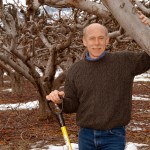Written by David Granatstein and Elizabeth Kirby, WSU Wenatchee
The area of certified organic apple production in Washington State grew by 37% in 2017, and is poised to grow further in 2018. In 2016, there were 16,191 acres of certified organic apples in the state, with another 4,244 acres intended for certification in 2017. Of the transition acres, only 60% were registered with a certifier. A survey of fruit companies was done in January 2017 to estimate the unregistered acres. The 2017 year ended with about 22,116 acres certified. This exceeded the estimate of 20,435 acres (which was based on the end number of 2016 plus the year 2 transition acres identified) by 1,681 acres, and illustrates the challenges of making accurate estimates.
WSDA data from 2017 indicate 2,378 acres in year 2 transition (T2), with about 1,100 acres specified as T2 with other certifiers. This suggests at least another 3,478 acres that are likely to be certified in 2018. There were also 565 acres not specified for the transition year. Using the 3,478 acre transition estimates from certifiers, there might be 25,594 acres certified in 2018. Using the T1 acres reported in the January 2017 survey (4,476 acres registered and unregistered), there might be 26, 592 acres certified in 2018.
WSDA shows another 1,200 acres in transition to become certified in 2019. This compares with 983 acres reported in the company survey of January 2017 for intended certification in 2019.
Thus, it looks like there may be 16-20% more certified organic apple acres in 2018 than in 2017, a smaller amount of growth than the 37% experienced in 2017. However, the 37% growth in area in 2017 translated to a 43% growth in harvested volume, or 4.7 million boxes more than 2016. If there is another 20% growth in volume in 2018, that would add 3.1 million boxes. Based on the previous 8 years, even years were “on” years for organic apple yield in the alternate bearing cycle. But this pattern was lost in 2017, and it is unclear whether 2018 will therefore be an “off” year which would moderate the increase in crop size. Over the past three alternate bearing cycles, the “off” year crop was from 2-16% smaller than the “on” year crop. So even if 2018 is an “off” year, this will not fully offset the added production from newly certified acres.
Contact
Professor / Sustainable Agriculture Specialist, Washington State University Tree Fruit Research and
Tel. 509.663.8181 x222
Email: granats@wsu.edu
http://tfrec.cahnrs.wsu.edu/organicag/
http://csanr.wsu.edu/trends-in-washington-agriculture/organic-statistics/

